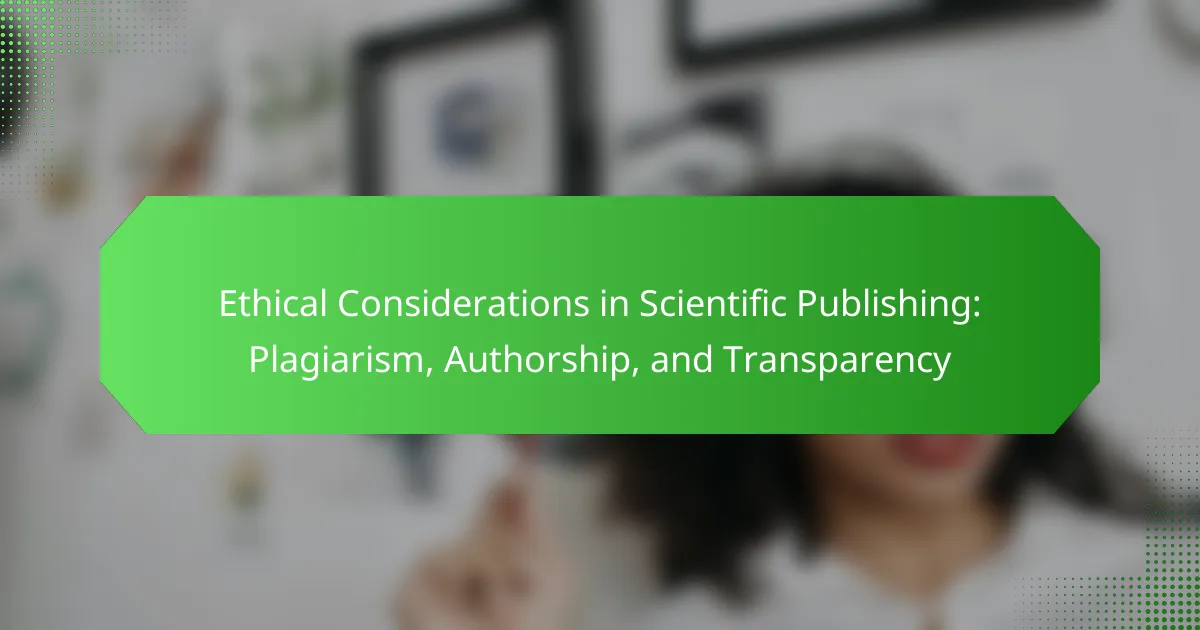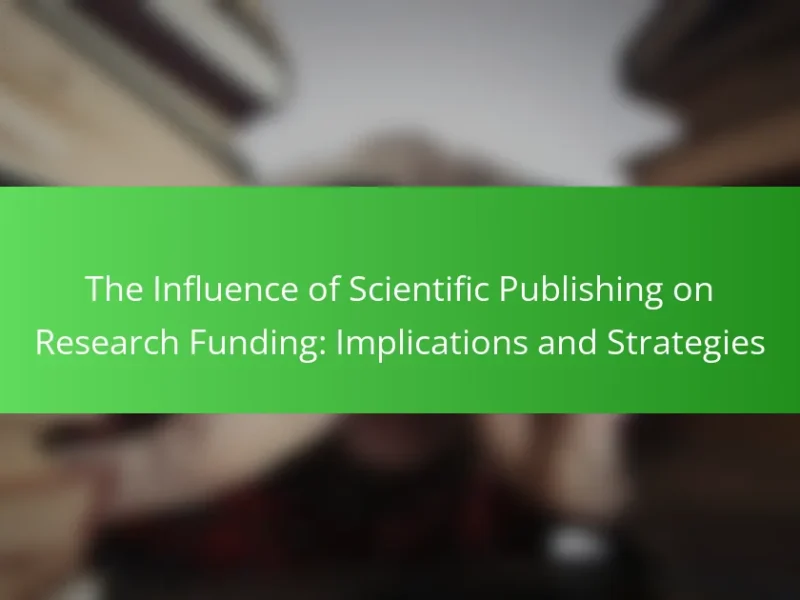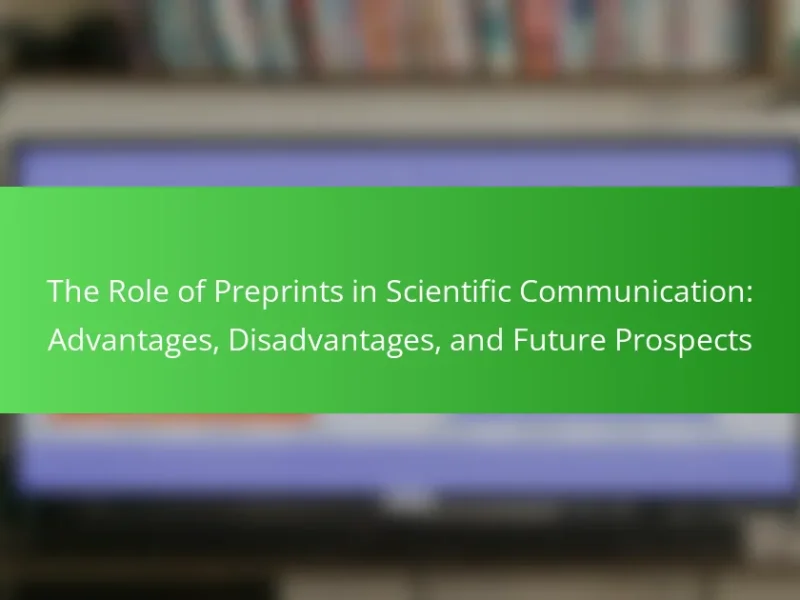Ethical considerations in scientific publishing encompass key elements such as plagiarism, authorship integrity, and transparency. Plagiarism is the unauthorized use of another’s work, which undermines research credibility and ethical standards. Authorship integrity ensures that all contributors are accurately credited, preventing disputes and maintaining trust within the scientific community. Transparency in research practices, including open data sharing and clear authorship disclosure, facilitates reproducibility and validation of findings, ultimately enhancing research quality. Implementing robust peer review processes and employing plagiarism detection tools further support these ethical principles, promoting a trustworthy scientific literature landscape.
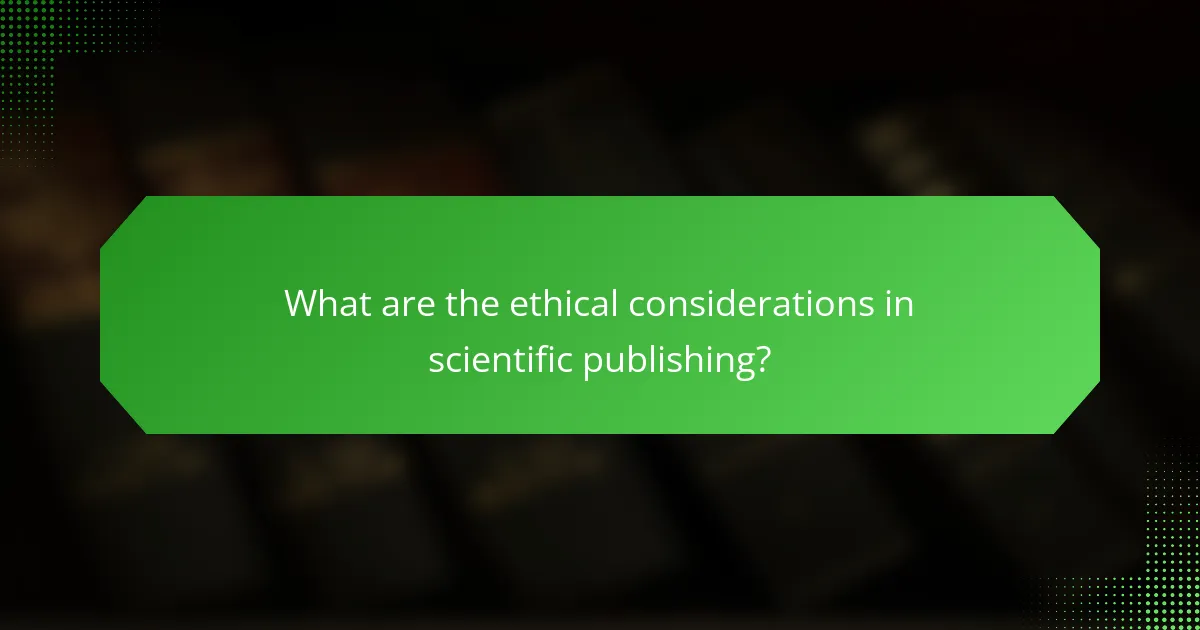
What are the ethical considerations in scientific publishing?
Ethical considerations in scientific publishing include plagiarism, authorship integrity, and transparency in research. Plagiarism involves using someone else’s work without proper attribution. This undermines the credibility of research and violates ethical standards. Authorship integrity requires that all contributors to a study are appropriately credited. Misrepresenting authorship can lead to disputes and diminish trust in the scientific community. Transparency involves openly sharing research data and methodologies. This allows for reproducibility and validation of findings. Adhering to these ethical principles is essential for maintaining the integrity of scientific literature.
Why is ethics important in scientific publishing?
Ethics is crucial in scientific publishing to ensure integrity and trustworthiness. It prevents misconduct such as plagiarism, fabrication, and falsification of data. Ethical standards promote transparency in research processes and findings. They ensure proper attribution of authorship, which acknowledges contributors’ efforts accurately. Adhering to ethical guidelines fosters a culture of accountability among researchers. This accountability enhances the credibility of scientific literature. A study by the Committee on Publication Ethics (COPE) emphasizes that ethical publishing practices are vital for maintaining public confidence in research. Without ethics, the scientific community risks undermining its own legitimacy and impact.
What are the potential consequences of unethical practices?
Unethical practices in scientific publishing can lead to severe consequences. These include damage to the credibility of the research and the individuals involved. Institutions may impose sanctions, including termination or retraction of published work. Researchers may face legal repercussions if misconduct is proven. The scientific community suffers from a loss of trust, impacting future collaboration and funding opportunities. According to a study published in the journal “Nature,” 20% of researchers admitted to having engaged in questionable research practices. This statistic highlights the prevalence and potential harm of unethical behavior in the field.
How do ethical standards influence scientific credibility?
Ethical standards significantly influence scientific credibility by ensuring integrity and trustworthiness in research. These standards promote honest reporting of data and results. They discourage practices like plagiarism and fabrication of results. Adhering to ethical guidelines fosters transparency in methodologies and funding sources. This transparency allows for better peer review and reproducibility of findings. Studies show that research adhering to ethical standards is more likely to be accepted in reputable journals. According to a 2017 study published in the journal “Nature,” ethical breaches can lead to retractions, damaging the credibility of both the research and the authors. Thus, ethical standards are foundational to maintaining scientific credibility.
What are the main ethical issues in scientific publishing?
The main ethical issues in scientific publishing include plagiarism, authorship disputes, and lack of transparency. Plagiarism involves using another’s work without proper attribution. This undermines the integrity of the research community. Authorship disputes arise when individuals disagree on who should be credited for a publication. This can lead to conflicts and hinder collaboration. Lack of transparency refers to the failure to disclose conflicts of interest or funding sources. This can bias research findings and erode public trust. According to a study published in the journal “Nature,” up to 30% of researchers have admitted to engaging in questionable research practices. This highlights the prevalence of ethical issues in the field.
How does plagiarism manifest in scientific work?
Plagiarism in scientific work manifests as the unauthorized use of others’ ideas, data, or text. This can occur through direct copying without citation, paraphrasing without acknowledgment, or presenting someone else’s research as one’s own. A study by the Committee on Publication Ethics (COPE) indicates that instances of plagiarism are increasingly prevalent in academic publishing. Additionally, self-plagiarism occurs when authors reuse their previous work without proper citation. According to a 2018 survey published in the journal “Nature,” 30% of researchers reported encountering plagiarism in their field. These manifestations undermine the integrity of scientific research and can lead to retractions and damage to reputations.
What are the different types of plagiarism?
The different types of plagiarism include direct plagiarism, self-plagiarism, mosaic plagiarism, and accidental plagiarism. Direct plagiarism occurs when someone copies text verbatim without attribution. Self-plagiarism involves reusing one’s own previously published work without acknowledgment. Mosaic plagiarism, also known as patchwork plagiarism, is when a writer borrows phrases from various sources and combines them without proper citation. Accidental plagiarism happens when a writer unintentionally fails to cite sources correctly or paraphrases poorly. Each type can lead to serious ethical violations in scientific publishing, emphasizing the need for transparency and proper attribution.
What is the significance of authorship in scientific publishing?
Authorship in scientific publishing signifies accountability and credit for research contributions. It ensures that individuals who have made substantial contributions to the work are recognized. Proper authorship attribution fosters transparency and integrity in the research process. It also helps prevent issues such as plagiarism and misrepresentation of work. The International Committee of Medical Journal Editors outlines criteria for authorship, reinforcing its importance. Accurate authorship reflects the collaborative nature of research, promoting a fair academic environment. Misattribution can lead to ethical violations and damage to reputations. Thus, authorship plays a critical role in maintaining trust in scientific literature.
How is authorship determined in collaborative research?
Authorship in collaborative research is determined by contributions to the research process. Key factors include the design, execution, analysis, and writing of the study. Each contributor’s role is assessed to establish their significance in the project. Guidelines from organizations like the International Committee of Medical Journal Editors (ICMJE) outline criteria for authorship. These criteria emphasize substantial contributions to conception, drafting, and final approval of the work. Additionally, all authors should agree on the final version before submission. This collaborative approach helps ensure accountability and transparency in research.
What ethical issues arise from disputes over authorship?
Disputes over authorship raise several ethical issues. Primarily, they can lead to questions of academic integrity. Misattribution of authorship can undermine the credibility of research. It may result in the exclusion of deserving contributors. Ethical conflicts may arise when contributions are not fairly recognized. Additionally, disputes can create a lack of trust among collaborators. This can hinder future research efforts. Ethical guidelines emphasize transparency in authorship criteria. Violations can lead to retractions or damage to reputations.
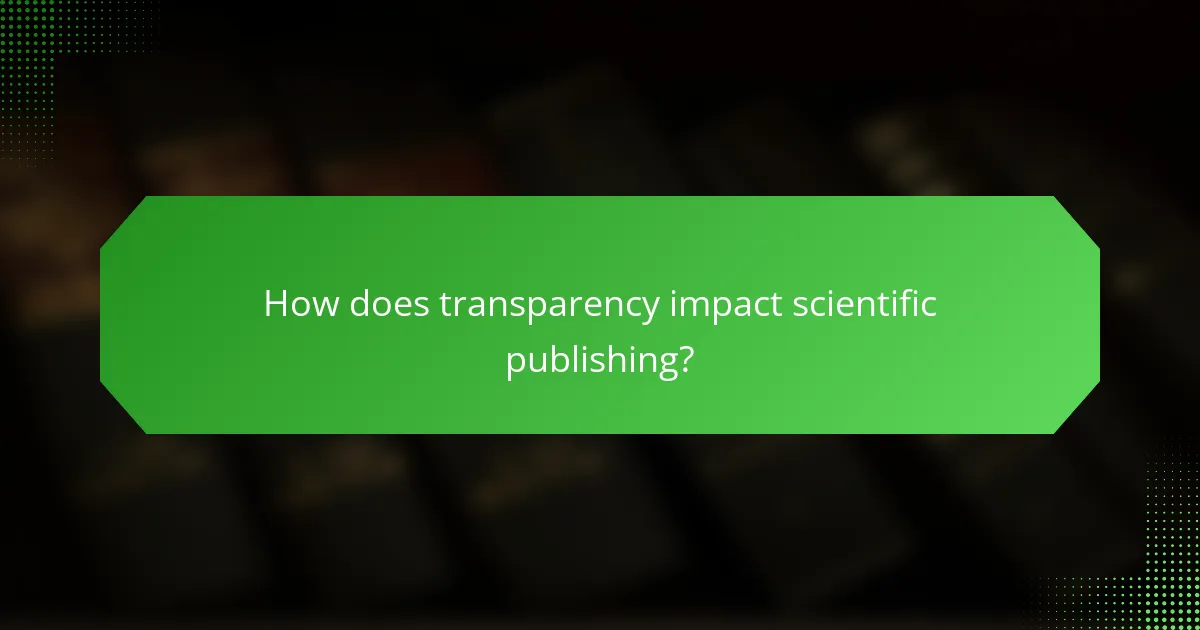
How does transparency impact scientific publishing?
Transparency enhances the integrity of scientific publishing. It fosters trust among researchers, institutions, and the public. Transparent practices include open data sharing and clear authorship disclosure. These practices allow for reproducibility of results, a core principle of scientific research. Studies show that transparency reduces instances of misconduct, such as plagiarism and data fabrication. A 2016 report by the National Academies of Sciences emphasizes that transparency leads to higher quality research outcomes. Furthermore, journals that adopt transparency guidelines often see increased citation rates. Overall, transparency is crucial for maintaining ethical standards in scientific publishing.
What does transparency entail in the context of scientific research?
Transparency in scientific research involves openly sharing methodologies, data, and findings. This practice allows for reproducibility and verification of results. Researchers must disclose conflicts of interest and funding sources. Transparency enhances trust in scientific findings among peers and the public. According to a study published in the journal “Nature,” transparency can significantly improve the quality and credibility of research. This study highlights that transparent practices lead to better collaboration and innovation in the scientific community.
How does transparency affect the reproducibility of research findings?
Transparency enhances the reproducibility of research findings by providing clear access to methodologies and data. When researchers share their processes openly, other scientists can replicate experiments accurately. This reduces ambiguity and increases trust in the results. A study published in the journal Nature found that transparent reporting leads to a higher likelihood of reproducibility. Specifically, it showed that studies with detailed methods had a reproducibility rate of over 80%. In contrast, those with vague descriptions often failed to yield consistent results. Therefore, transparency is crucial for validating research and advancing scientific knowledge.
Why is data sharing considered an ethical obligation?
Data sharing is considered an ethical obligation because it promotes transparency and accountability in research. Sharing data allows other researchers to verify findings and reproduce results. This practice enhances the credibility of scientific work. It also fosters collaboration and accelerates innovation. Ethical guidelines from organizations, such as the American Psychological Association, support data sharing. These guidelines emphasize the need for openness in research to advance knowledge. Furthermore, data sharing can lead to more informed decision-making in policy and practice. Overall, it is a fundamental aspect of responsible research conduct.
What are the implications of a lack of transparency?
A lack of transparency in scientific publishing can lead to significant ethical implications. It may result in diminished trust among researchers, institutions, and the public. When transparency is absent, the credibility of research findings is often questioned. This skepticism can hinder scientific progress and collaboration. Additionally, it can foster an environment where plagiarism and misconduct thrive. According to a study published in the journal “Nature,” 70% of scientists believe that lack of transparency contributes to research misconduct. Furthermore, a lack of transparency can impede the reproducibility of research, as other scientists cannot verify methodologies or results. Ultimately, these implications can undermine the integrity of the entire scientific community.
What challenges does a lack of transparency pose for peer review?
A lack of transparency in peer review presents significant challenges. It can lead to biases in the review process. Reviewers may favor certain authors or institutions without disclosing conflicts of interest. This can compromise the integrity of the research evaluation. Additionally, a lack of transparency can hinder accountability. Authors may not know the criteria used for their manuscript’s assessment. This can create distrust in the publication process. Research shows that transparent peer review enhances the quality of published work. Studies indicate that transparency can improve reviewer accountability and reduce bias.
How can institutions promote transparency in research?
Institutions can promote transparency in research by implementing open access policies. Open access allows research findings to be freely accessible to the public. This practice enhances the visibility of research and fosters collaboration. Additionally, institutions can adopt rigorous peer review processes. A strong peer review ensures that research is critically evaluated before publication.
Institutions should also encourage the use of pre-registration for studies. Pre-registration involves outlining research objectives and methods before conducting the study. This practice reduces the risk of selective reporting. Furthermore, institutions can support data sharing initiatives. Sharing raw data allows other researchers to verify results and replicate studies.
Training researchers on ethical practices is crucial. Educating researchers about transparency standards promotes responsible conduct. Institutions can establish clear guidelines for authorship and contributions. Clear authorship guidelines help prevent disputes and clarify accountability.
By fostering a culture of openness, institutions can enhance trust in research. Transparency ultimately strengthens the integrity of the scientific community.
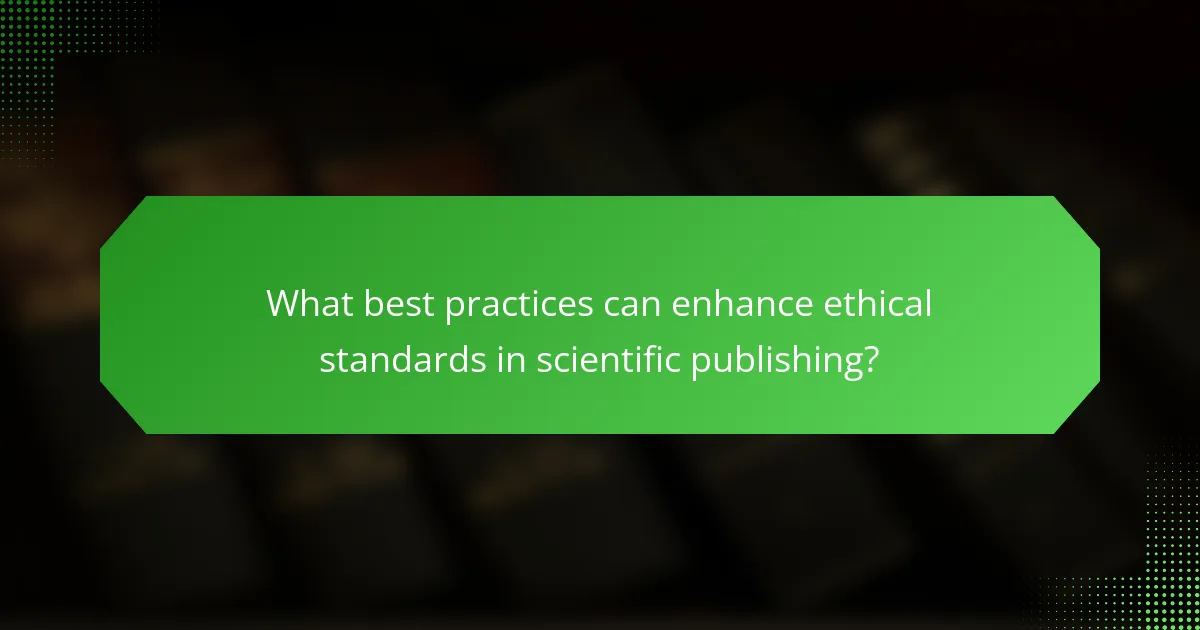
What best practices can enhance ethical standards in scientific publishing?
Implementing robust peer review processes enhances ethical standards in scientific publishing. This ensures that research is evaluated by experts before publication. Transparency in authorship is crucial. Clear disclosure of contributions prevents issues related to plagiarism and misattribution. Journals should enforce strict guidelines against plagiarism. Utilizing plagiarism detection software can help maintain integrity. Regular training for authors and reviewers on ethical standards is essential. This increases awareness of best practices in research ethics. Adopting open data policies promotes transparency. Sharing data allows for verification and reproducibility of research findings.
How can researchers avoid plagiarism effectively?
Researchers can avoid plagiarism effectively by properly citing all sources. Accurate citation gives credit to original authors and acknowledges their contributions. Researchers should use quotation marks for direct quotes and paraphrase effectively. Paraphrasing involves rewording ideas while maintaining the original meaning. Utilizing plagiarism detection software can help identify unintentional similarities with existing works. Maintaining thorough notes during research prevents confusion about source attribution. Understanding the specific citation style required by the publication is essential for proper formatting. Regularly reviewing institutional guidelines on plagiarism can reinforce ethical research practices.
What tools are available to check for plagiarism?
Plagiarism detection tools include Turnitin, Grammarly, and Copyscape. Turnitin is widely used in academic institutions for checking student submissions. Grammarly offers a plagiarism checker alongside grammar and style suggestions. Copyscape is popular among web content creators for ensuring originality. Each tool compares text against a vast database of sources. They provide reports highlighting potential matches and similarities. These tools help maintain integrity in scientific publishing. Their effectiveness is supported by their adoption in educational and professional settings.
What strategies can ensure proper citation practices?
Establishing proper citation practices involves several key strategies. First, familiarize yourself with citation styles relevant to your field. Common styles include APA, MLA, and Chicago. Second, maintain accurate records of all sources used during research. This includes author names, publication dates, and page numbers. Third, utilize citation management tools like EndNote or Zotero. These tools help organize references and generate citations automatically. Fourth, educate yourself on the concept of plagiarism. Understanding what constitutes plagiarism helps avoid unintentional misuse of sources. Fifth, review and revise citations before submission. Double-checking ensures all sources are correctly cited. Lastly, seek feedback from peers or mentors on citation practices. Their insights can help improve your citation skills. These strategies collectively promote ethical writing and transparency in scientific publishing.
What are the recommendations for ethical authorship?
Ethical authorship recommendations include ensuring all contributors are appropriately credited. Each author should have made a significant intellectual contribution to the work. Transparency in disclosing conflicts of interest is essential. Authors must avoid plagiarism by properly citing sources. They should also respect the rights of others in terms of data and materials. Regular communication among co-authors is important for maintaining accountability. Adherence to the guidelines set by relevant journals or institutions is crucial. These practices promote integrity and trust in the research community.
How can researchers navigate authorship disputes?
Researchers can navigate authorship disputes by establishing clear authorship criteria at the beginning of a project. They should refer to guidelines from organizations like the International Committee of Medical Journal Editors. Open communication among team members is essential to clarify contributions. Documenting each member’s contributions can help resolve conflicts later. Regular meetings can ensure everyone is on the same page regarding authorship. If disputes arise, seeking mediation from a neutral party can be beneficial. Many institutions have policies in place to address such disputes, providing a formal process for resolution. These steps can help maintain transparency and fairness in authorship decisions.
What guidelines should be followed for fair credit allocation?
Fair credit allocation guidelines include ensuring all contributors are acknowledged based on their actual contributions. The International Committee of Medical Journal Editors (ICMJE) outlines specific criteria for authorship. These criteria require substantial contributions to the conception, design, execution, or interpretation of the research. Additionally, authors should draft or critically revise the work for important intellectual content.
All authors must approve the final version to be published. Transparency in the contributions of each author is crucial. This ensures accountability and recognition of individual efforts. Journals often require detailed author contribution statements to clarify roles. Adhering to these guidelines promotes ethical practices in scientific publishing.
How can transparency be improved in scientific publishing?
Transparency in scientific publishing can be improved through several key practices. First, the adoption of open access publishing allows wider access to research findings. This model ensures that research is available to all, fostering greater scrutiny and collaboration. Second, implementing open data policies encourages researchers to share their raw data. This practice enables others to validate findings and conduct further analyses. Third, establishing clear guidelines for authorship can clarify contributions and responsibilities. This reduces disputes and enhances accountability. Fourth, utilizing preprint servers allows researchers to share findings before peer review. This accelerates the dissemination of knowledge and invites early feedback. Lastly, promoting the use of reporting guidelines can standardize how research is presented. This ensures that essential information is consistently included, making it easier to assess the quality and reliability of studies.
What role do journals play in promoting transparency?
Journals play a critical role in promoting transparency in scientific publishing. They establish rigorous peer-review processes that ensure research quality and integrity. This peer review allows experts to evaluate the methodology and findings before publication. Furthermore, journals often require authors to disclose conflicts of interest, enhancing accountability. Many journals also encourage or mandate data sharing to allow for independent verification of results. Guidelines for ethical reporting are provided to authors, fostering a culture of honesty. Transparency is further supported by open access models that make research freely available to the public. This accessibility enables broader scrutiny and discussion within the scientific community.
How can researchers advocate for open access to data?
Researchers can advocate for open access to data by promoting transparency in their work. They can share their datasets in public repositories. This practice enhances reproducibility and trust in scientific findings. Researchers can also collaborate with institutions to develop open access policies. These policies can encourage funding agencies to support data sharing initiatives. Engaging in public discussions about the benefits of open data is essential. They can highlight successful case studies where open access has led to significant advancements. Additionally, researchers can participate in advocacy groups focused on data sharing. This collective effort can amplify their message and influence policy changes.
What practical steps can researchers take to uphold ethical standards?
Researchers can uphold ethical standards by following specific guidelines. They should obtain informed consent from participants before conducting studies. This ensures transparency and respect for individuals’ rights. Researchers must also ensure accurate data reporting. Misrepresentation can lead to severe consequences, including retraction of published work. They should engage in peer review processes to maintain quality and integrity. Collaborating with colleagues can foster a culture of accountability. Additionally, researchers must avoid plagiarism by properly citing sources. Adhering to institutional review board guidelines is crucial for ethical compliance. Regular training on ethical standards can enhance awareness and adherence.
How can regular training on ethics benefit researchers?
Regular training on ethics enhances researchers’ understanding of ethical standards. It fosters responsible conduct in research practices. This training helps prevent misconduct such as plagiarism and data fabrication. Researchers equipped with ethical knowledge are more likely to maintain integrity. It also promotes transparency in the publishing process. Ethical training encourages collaboration and respect among peers. According to a study by the National Institutes of Health, ethical training reduces instances of research misconduct. This evidence supports the importance of ongoing ethics education for researchers.
What resources are available for staying informed about ethical practices?
Resources available for staying informed about ethical practices include academic journals, professional organizations, and online courses. Academic journals such as “Science and Engineering Ethics” publish peer-reviewed articles on ethical issues in research. Professional organizations like the American Psychological Association provide guidelines and resources for ethical conduct. Online platforms such as Coursera and edX offer courses on research ethics. These resources help individuals understand ethical standards and practices in various fields.
The main entity of this article is ethical considerations in scientific publishing, focusing on key issues such as plagiarism, authorship integrity, and transparency. The article outlines the importance of adhering to ethical standards to maintain the credibility of research, highlighting the consequences of unethical practices, including damage to reputations and loss of trust in the scientific community. It discusses the significance of proper authorship attribution, the various forms of plagiarism, and the role of transparency in enhancing research reproducibility and accountability. Additionally, the article provides best practices for researchers to uphold ethical standards and improve transparency in scientific publishing.
